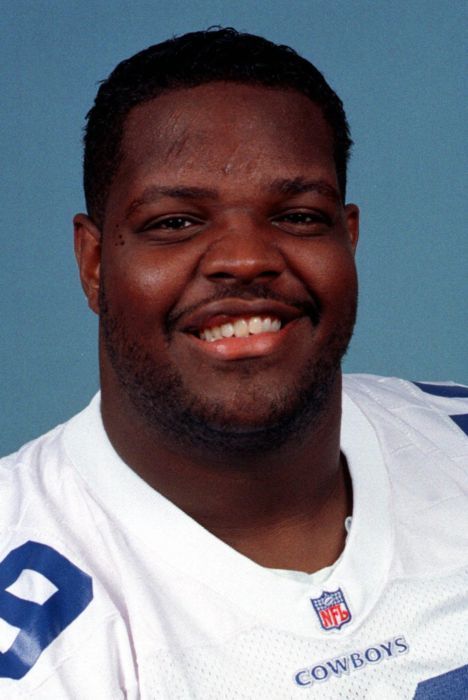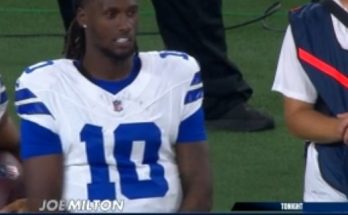In the blood-soaked trenches of the NFL’s golden era, one name stood as a fortress of intimidation and unrelenting force—Erik Williams, the Dallas Cowboys’ right tackle who became the gatekeeper to greatness in the 1990s. He was not a celebrity lineman, not a media darling, and certainly not gentle. He was brutal. Unforgiving. Legendary. For a dynasty built on Hall of Famers, it was Williams who set the tone in the most violent corner of the field.
Often overlooked in discussions of Dallas Cowboys royalty, Williams was the man who made sure Troy Aikman stayed upright, Emmitt Smith had daylight, and Michael Irvin had time to get open. He was not just an offensive lineman—he was a relentless predator in shoulder pads. And for those who lined up against him, he was a waking nightmare.
This is the untold fury of Erik Williams.
The Making of a Menace
Born on September 7, 1968, in Philadelphia, Pennsylvania, Erik George Williams didn’t start as a blue-chip recruit or a first-round wonder. In fact, he was lightly recruited out of John Bartram High School and ended up playing at Central State University, an HBCU in Wilberforce, Ohio, far from the spotlight. But what he lacked in fame, he made up for in ferocity. Williams turned Central State into his personal proving ground, dominating at the NAIA level and catching the attention of NFL scouts.
It was Jimmy Johnson, the architect of the Cowboys’ 90s renaissance, who saw what others didn’t. Dallas picked Williams in the third round of the 1991 NFL Draft—a move that would reshape the franchise’s offensive identity. He wasn’t a project. He was an immediate hammer in a league full of nails.
Welcome to the Wall: The Rise of a Beast
By 1992, Williams was the starting right tackle for one of the most formidable offensive lines in football history—the famous “Great Wall of Dallas.” Alongside Nate Newton, Mark Tuinei, Kevin Gogan, and Mark Stepnoski, Williams anchored an offense that mauled defenses week in and week out.
But Williams wasn’t just good—he was dominant. His hands were like steel clamps, his punch could stop a bull rush dead, and his footwork was deceptively nimble. Standing 6-foot-6 and weighing 325 pounds, he had the rare combination of mass and mobility. When he engaged, defenders rarely disengaged.
Reggie White, the “Minister of Defense” and arguably the greatest defensive end of all time, once said Williams was “the only man who ever blocked me one-on-one and got the better of it.” That’s not hyperbole. In a legendary 1992 Monday Night Football game between the Cowboys and Eagles, Williams completely neutralized White—a feat considered impossible at the time.
It wasn’t just a good game. It was the defining moment of Williams’ career, the night he crossed into NFL folklore.
Silent But Savage
Despite his dominance, Williams never sought the limelight. He wasn’t loud. He wasn’t flashy. He just hit people. His on-field style was built around punishment—he delivered it and absorbed it with the mechanical coldness of a war machine.
Defensive linemen feared lining up against Williams not just because of his strength, but because of his nastiness. He played with a mean streak, the kind that dared you to match his violence. Few could. His arms, long and powerful, delivered uppercuts in close quarters that rattled teeth. He finished blocks long after the whistle. He stared through people, not at them.
In the Cowboys’ three Super Bowl runs (1992, 1993, and 1995 seasons), Williams played a vital role. Smith led the league in rushing. Aikman was barely touched. And Williams was right there, dominating without headlines, without flash—just rage and results.
A Life-Altering Crash
In 1994, when Williams was at the peak of his power, tragedy struck.
A horrific car accident in October of that year nearly ended his career and his life. Williams suffered severe injuries to his knee and face and missed the remainder of the 1994 season. Doctors weren’t sure he’d ever play again. For a player who won with leverage, balance, and power, the injury was devastating.
Yet Williams returned.
By 1995, he was back in the lineup, helping the Cowboys win their third Super Bowl in four years. While he was never quite the same explosive athlete, his mental edge and technique carried him. He continued to start until 2000, finishing his career with a brief stint in Baltimore.
The fact that he came back at all was a miracle. The fact that he played at a high level after such trauma speaks to the indomitable will that made Erik Williams a cornerstone of the Cowboys’ dynasty.
Respected by Legends, Forgotten by History
Despite his accomplishments, Williams remains one of the most underappreciated legends in NFL history. He was a four-time Pro Bowler and three-time First-Team All-Pro, but somehow, he’s not in the Hall of Fame.
Why?
Because Williams didn’t politic for attention. He didn’t feed the media. He didn’t boast. And his position—right tackle—has traditionally been overlooked in favor of flashier roles. But make no mistake: every Hall of Fame-caliber Cowboy from that era owes a debt to Erik Williams.
Ask Emmitt Smith. In his Hall of Fame speech, Smith said, “If you didn’t have Erik Williams at right tackle, I don’t know if I’m standing here today.”
Ask Troy Aikman. In interviews, Aikman has consistently credited Williams as the anchor of the offensive line.
Ask Reggie White—oh wait, you already know what he said.
Legacy of Violence and Virtue
Off the field, Williams kept a low profile. There were no brand endorsements, no media tours. He coached high school football after retirement and largely stayed out of the spotlight. Some legal troubles later in life threatened to obscure his football legacy, but his time in Dallas remains pristine—a monument to physical dominance.
In today’s NFL, where linemen are lauded for dancing feet and pass-block win rates, Williams would still be a star. But the metrics wouldn’t fully capture what he brought: fear. He controlled the line not with numbers, but with presence. There’s no PFF stat for making another grown man question his career choices.
A Final Reckoning: Why Erik Williams Belongs in Canton
It’s time for the football world to correct an injustice. If there’s room in Canton for dominant linemen—and there should be—then Erik Williams belongs. He was the bouncer to three Super Bowl titles, the bodyguard of a Hall of Fame quarterback, and the bulldozer behind the NFL’s all-time leading rusher.
Let’s lay it out:
- 3× Super Bowl Champion
- 4× Pro Bowl Selection (1993–1996)
- 3× First-team All-Pro (1993–1995)
- Neutralized Reggie White in his prime
- Heart of the Great Wall of Dallas
His résumé is undeniable.
The Final Word
Erik Williams is a name whispered with reverence in the film rooms of former defensive linemen. He was the kind of player who left bruises on tape and welts on ribs. The NFL is built on men like him—the unglorified titans who make the stars shine brighter.
For a decade, Williams redefined what it meant to play right tackle. He didn’t just block—you could say he broke men. He didn’t just protect his quarterback—he punished yours. And he didn’t just play the game—he owned his piece of the field like a gladiator who never lost a duel.
The story of the Dallas Cowboys’ 1990s dynasty is incomplete without him. The Super Bowls. The records. The highlight reels. They all came through the storm—and Erik Williams was that storm.



